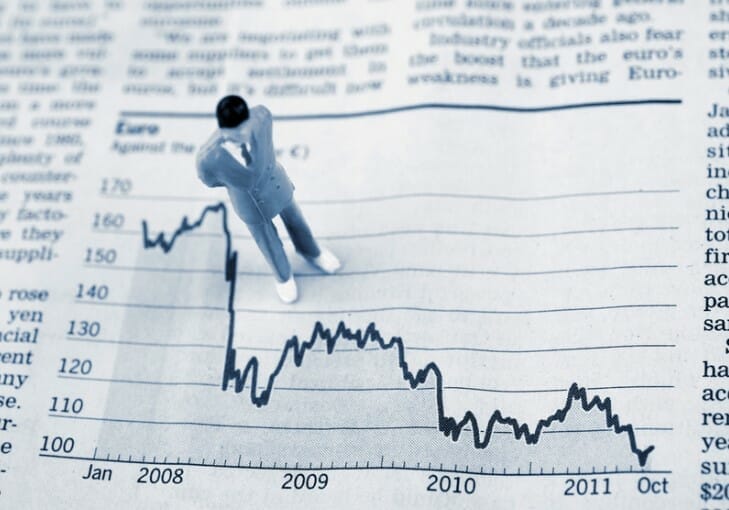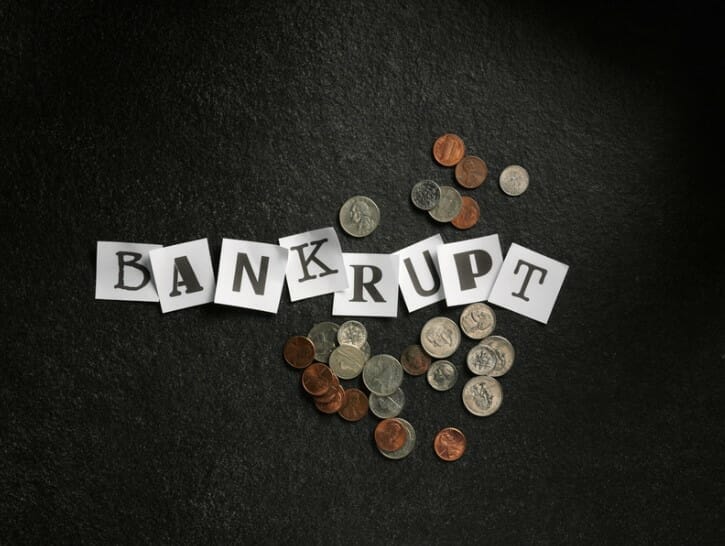Post updated: 7/14/2023
A negative P/E ratio can be concerning. You can’t really compare a negative P/E ratio with other stocks’ P/E’s. I’ll discuss 3 major reasons a company might have a negative P/E. This blog post will be split into these sections:
[Click to Skip Ahead]
- The Basics of a Negative P/E
- 1—Negative Earnings to Reinvest for Growth
- 2—A Company With Temporary Struggles in Profitability
- 3—The Company’s Business is Deteriorating
- The Real Risk Factor with a Negative P/E
Be sure to check out the Investor Takeaway for an additional resource to consider.

The Basics of a Negative P/E
To define what a negative P/E ratio implies, we need to refresh our understanding of the P/E ratio. To calculate P/E, simply take price divided by earnings, like this:
P/E = Price to Earnings
= Price / Earnings
= Stock Price / EPS
EPS = Earnings Per Share.
Notice that Price can never be a negative number. Either it’s a positive value, or zero.
That means that if a P/E ratio is negative, it is only because a company has negative EPS. In other words, negative earnings. Whether negative earnings is bad, or would cause you to change your investment decision between a buy or a sell is the million dollar question.
In general, there’s going to be three major categories of why a company has negative earnings:
- The company is heavily reinvesting for growth and does not take a profit
- The company has run into short term struggles and had either high expenses or low demand
- The company’s business is deteriorating and it is a huge red flag on its future
Let’s cover each situation separately.
1—Negative Earnings to Reinvest for Growth
Whether negative earnings are bad depends on what your investment strategy is.
If you primarily look to invest in growth stocks, then a negative P/E ratio should have little bearing.
But it’s important to keep in mind that there’s a big difference between a young growth company with negative earnings, and a once profitable company suddenly turned negative.
With young growth companies, you’ll tend to see negative earnings as they first IPO. They should have a massive TAM (total addressable market). This allows their heavy reinvestments to become an eventual profitable endeavor.
However, this can be extremely hard to know ahead of time. Not all reinvestments become profitable. It’s why many growth investors tend to have very large portfolios with many stocks, since many of those ventures probably won’t succeed.
You have many problems which happen with scale, and so just because a stock has a negative P/E now doesn’t mean they will have positive earnings down the line.

You really have to analyze many other aspects of the business:
- Where are the losses coming from?
- Marketing investments, or excessive compensation?
- More expensive Cost of Goods Sold, or R&D investment?
- Is the company getting incrementally better or worse with profitability?
- Is the company taking market share or not?
Many of these questions are very subjective. It can make buying negative P/E ratio stocks very difficult, especially when they are young, growth companies.
2—A Company With Temporary Struggles in Profitability
The next situation is another ambiguous scenario. You may have a sense of whether current struggles are short term or long term. But the reality is that it’s much easier to say this with hindsight.
The rearview mirror is always 20-20 in business. So, we should really be careful that we are not overconfident in our analyses. That includes whether a company’s negative earnings are short or long term in nature.
Remember that it’s not about what Wall Street thinks about a company’s situation, but what business reality actually is.
So you’re going to want to analyze the business and ask yourself:
Has anything fundamentally changed with the business?
To answer that you’ll have to answer what has caused the company’s profitability to struggle. You can start by searching through the numbers, such as inside the 10-Q and 10-K, and looking for discrepancies.
Another resource would be a company’s earnings calls. Management should be able to provide a reason why it has stumbled with profitability.
From there, you should fact check with other sources. If management says it’s an industry-wide problem, check with the recent results of competitors in the same industry.
If management says they had one-time expenses, do your due diligence. Look throughout the company’s history; make sure this isn’t a common theme with management. Also confirm your thesis by checking the history of the income statement and notes to the financials.
3—The Company’s Business is Deteriorating
Some businesses can turn it around. But some simply can’t.
Be on the lookout for secular declines.
The hard reality of capitalism is that there is creative destruction happening all the time.
As new innovations and better customer solutions and services come out, old businesses are replaced.
Countless examples throughout history have shown this—from the horse and buggy to the printing press to CD manufacturing.
Some companies are able to adapt to secular changes. These might leverage their strong position and/or balance sheet to innovate, and lead a new market or trend. But, many companies don’t, and as an investor, it’s your responsibility to make a rational evaluation on how a company is executing on that. This, again, requires taking emotions out of the picture.
If a company has a negative P/E ratio now, and you find through your analysis that the business or industry is declining from secular trends, this is a surefire indicator to sell!
The Real Risk Factor with a Negative P/E
Before you go pulling the trigger on your stock with a negative P/E ratio, consider one last critical factor.
I did a study examining the 30 biggest bankruptcies of the 21st Century. Through this I found that the #1 most common factor for companies, in the year before declaring bankruptcy, was negative earnings.

It was so pervasive and widespread that it was impossible to ignore.
There are many different metrics within a company’s financial statements, but one of the easiest to look at is earnings. This makes the P/E ratio a popular metric.
And yet despite all of this attention on P/E and earnings, you never really hear people talking about the danger of negative earnings.
Negative Earnings and the Business Cycle
With many businesses, they have fixed costs which have to be paid regardless if they can bring in revenues or not. It can take the form of a retailer needing to pay rent on their property, or a technology firm making huge interest payments on their debt.
Simply said, being in business means taking on certain financial obligations. If those are not met, it will require an infusion of capital or a default leading to bankruptcy.
During prosperous times in the economy and a bull market, capital usually runs freely. Public companies can either borrow additional funds or issue equity to raise them, when needed.
But the problem with relying on other sources for funding is that liquidity and access to capital tends to disappear all at the same time. Of course, that is when those struggling businesses need it the most.
A retailer in a cyclical industry might see huge revenue declines because of reduced demand during a recession. That is usually the same time that lenders and investors are also tightening their belts.
When buying a stock with a negative P/E ratio, you have to consider these factors, which play into whether a stock will even recover at all.
Just because a company has a valuable brand or franchise doesn’t mean that the stock will survive. Many failing companies will default and then sell their brands or assets after bankruptcy. This does no good to shareholders, who are wiped out.
And it all starts with negative earnings, which are generally signaling a difficulty in paying fixed costs.
Remember this judicious quote from Warren Buffett which has undoubtedly played a big part in his success:
We never want to count on the kindness of strangers in order to meet tomorrow’s obligations. When forced to choose, I will not trade even a night’s sleep for the chance of extra profits.
Warren Buffett
Investor Takeaway
When buying a stock with a negative P/E ratio, you can’t get away from these tough facts.
If you want to learn more about the bankruptcy research I did, pick up the Value Trap Indicator book and read about (and see!) the major bankruptcies and the financial numbers which marked distinct warning signs beforehand.
The fact of the matter is that a buy, sell, or hold on a stock with a negative P/E could be a different independent decision for every single company.
That said, I really hope you don’t take these warnings lightly.
Having rules and boundaries to what you will and won’t accept as an investor is a fantastic way to protect you from being run over in the market.
Don’t justify obviously bad behavior just because you love a company. Take negative earnings seriously.

Andrew Sather
Andrew has always believed that average investors have so much potential to build wealth, through the power of patience, a long-term mindset, and compound interest.
Related posts:
- 6 Examples of Negative Earnings Leading to Bankruptcy in the Stock Market I’ve had the controversial take that investors should avoid stocks with negative earnings. This is because my research into the biggest bankruptcies of the 21st...
- How to Find Negative Retained Earnings in a 10-K – Does it Indicate Distress? Stockholders’ equity, also called book value, is the company’s assets minus its liabilities. We talk about tangible book value when we value investors discuss shareholders’...
- What’s the PEG Ratio in Finance – Does it Work on Large Companies? Price-to-earnings, or P/E ratio as it is also known, is probably the most recognizable metric used to value stocks. Are they the most useful? Well,...
- Negative PEG Ratio Implications: What Does It Mean? Why Does It Happen? Updated 10/12/2023 The implications for a negative PEG ratio might not be as bad as you think. It all depends on the reason behind the...
